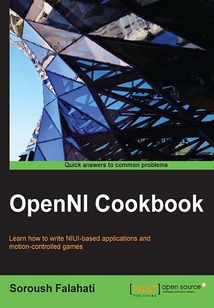舉報 

會員
OpenNI Cookbook
最新章節:
Index
ThisisaCookbookwithplentyofpracticalrecipesenrichedwithexplainedcodeandrelevantscreenshotstoeaseyourlearningcurve.IfyouareabeginneroraprofessionalinNIUIandwanttowriteseriousapplicationsorgames,thenthisbookisforyou.EvenOpenNI1andOpenNI1.xprogrammerswhowanttomovetonewversionsofOpenNIcanusethisbookasastartingpoint.ThisbookusesC++astheprimarylanguagebuttherearesomeexamplesinC#andJavatoo,soyouneedtohaveaboutabasicworkingknowledgeofCorC++formostcases.
目錄(60章)
倒序
- 封面
- 版權信息
- Credits
- About the Author
- About the Reviewers
- www.PacktPub.com
- Preface
- Chapter 1. Getting Started
- Introduction
- Downloading and installing OpenNI
- Downloading and installing NiTE
- Downloading and installing the Microsoft Kinect SDK
- Connecting Asus Xtion and PrimeSense sensors
- Connecting Microsoft Kinect
- Chapter 2. OpenNI and C++
- Introduction
- Creating a project in Visual Studio 2010
- OpenNI class and error handling
- Enumerating a list of connected devices
- Accessing video streams (depth/IR/RGB) and configuring them
- Retrieving a list of supported video modes for depth stream
- Selecting a specific device for accessing depth stream
- Listening to the device connect and disconnect events
- Opening an already recorded file (ONI file) instead of a device
- Chapter 3. Using Low-level Data
- Introduction
- Configuring Visual Studio 2010 to use OpenGL
- Initializing and preparing OpenGL
- Reading and showing a frame from the image sensor (color/IR)
- Reading and showing a frame from the depth sensor
- Controlling the player when opening a device from file
- Recording streams to file (ONI file)
- Event-based reading of data
- Chapter 4. More about Low-level Outputs
- Introduction
- Cropping and mirroring frames right from the buffer
- Syncing image and depth sensors to read new frames from both streams at the same time
- Overlaying the depth frame over the image frame
- Converting the depth unit to millimetre
- Retrieving the color of the nearest point without depth over color registration
- Enabling/disabling auto exposure and auto white balance
- Chapter 5. NiTE and User Tracking
- Introduction
- Getting a list of all the active users
- Identifying and coloring users' pixels in depth map
- Reading users' bounding boxes and center of mass
- Event-based reading of users' data
- Chapter 6. NiTE and Hand Tracking
- Introduction
- Recognizing predefined hand gestures
- Tracking hands
- Finding the related user ID for each hand ID
- Event-based reading of hands' data
- Working sample for controlling the mouse by hand
- Chapter 7. NiTE and Skeleton Tracking
- Introduction
- Detecting a user's pose
- Getting a user's skeleton joints and displaying their position in the depth map
- Designing a simple pong game using skeleton tracking
- Index 更新時間:2021-08-13 16:30:28
推薦閱讀
- Learning LibGDX Game Development(Second Edition)
- Getting Started with Gulp(Second Edition)
- 從零開始:數字圖像處理的編程基礎與應用
- 自己動手寫Java虛擬機
- AWS Serverless架構:使用AWS從傳統部署方式向Serverless架構遷移
- 算法大爆炸:面試通關步步為營
- PostgreSQL技術內幕:事務處理深度探索
- Visual Basic程序設計習題解答與上機指導
- Spring實戰(第5版)
- Spring Boot Cookbook
- Creating Mobile Apps with jQuery Mobile(Second Edition)
- MySQL入門很輕松(微課超值版)
- ArcGIS for Desktop Cookbook
- SpringBoot從零開始學(視頻教學版)
- Python Machine Learning Cookbook
- Java Web動態網站開發(第2版·微課版)
- Learning Android Application Development
- jQuery Mobile從入門到精通
- INSTANT Fancybox
- Machine Learning with R Cookbook
- Visual C++程序開發參考手冊
- Python數據分析從入門到精通(第2版)
- Python全案例學習與實踐
- Learning IPython for Interactive Computing and Data Visualization
- 明解Python
- Kivy:Interactive Applications and Games in Python(Second Edition)
- 輪式自主移動機器人編程實戰
- 數據分析與挖掘:R語言
- Cocos2d-x學習筆記:完全掌握JS API與游戲項目開發 (未來書庫,觸控未來官方教材)
- Mastering Microservices with Java 9(Second Edition)

